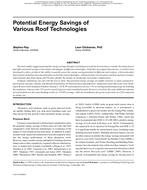
Buildings XI Conference — Potential Energy Savings of Various Roof Technologies
- Comments Off on Buildings XI Conference — Potential Energy Savings of Various Roof Technologies
- ASHRAE
Previous studies suggest potential for energy savings through cool and green roofs but do not always consider the many factors
that affect potential savings or the relative advantages of different technologies. To further investigate these factors, a tool has been
developed to allow architects the ability to quickly assess the energy-saving potential of different roof systems. A first-principles
heat transfer model has been developed for each of the roof technologies, with particular care for green roof heat and mass transfer.
Experimental data from Japan and Florida validate the models by predicting roof surface temperatures.
Example simulations are run with the tool to show that potential energy savings are highly sensitive to many parameters,
particularly roof type, climate, and amount of insulation. To illustrate these dependencies, simulations show that a one-story building
in Boston with a modified-bitumen roof and 2.7 m2K/W roof insulation can save 13% in cooling and heating energy by doubling
the insulation, whereas only 12% can be saved if a green roof is installed instead. However, in Lisbon, the same additional amount
of roof insulation to the same building results in –0.010% savings, while the installation of a green roof results in a 26% reduction
in energy use.
Citation: Thermal Performance, International Conference, 2010
Product Details
- Published:
- 2010
- File Size:
- 1 file , 3.1 MB
- Product Code(s):
- D-BUILDINGSXI-37

